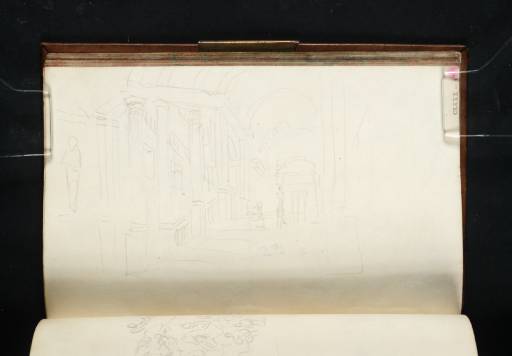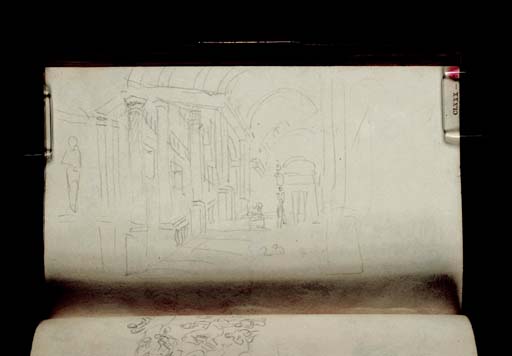Joseph Mallord William Turner The Staircase by the Sala a Croce Greca, in the Museo Pio-Clementino, the Vatican 1819
Image 1 of 2
Joseph Mallord William Turner,
The Staircase by the Sala a Croce Greca, in the Museo Pio-Clementino, the Vatican
1819
Joseph Mallord William Turner 1775–1851
Folio 48 Recto:
The Staircase by the Sala a Croce Greca, in the Museo Pio-Clementino, the Vatican 1819
D15196
Turner Bequest CLXXX 47
Turner Bequest CLXXX 47
Pencil on paper 101 x 161 mm
Inscribed by the artist in pencil ‘23’ bottom centre of sketch
Inscribed by John Ruskin in red ink ‘47’ top right, ascending right-hand edge
Stamped in black ‘CLXXX 47’ top right, ascending right-hand edge
Inscribed by John Ruskin in red ink ‘47’ top right, ascending right-hand edge
Stamped in black ‘CLXXX 47’ top right, ascending right-hand edge
Accepted by the nation as part of the Turner Bequest 1856
References
1909
A.J. Finberg, A Complete Inventory of the Drawings of the Turner Bequest, London 1909, vol.I, p.533, as ‘The Hall of the Greek Cross’.
1982
Cecilia Powell, ‘Topography, Imagination and Travel: Turner’s Relationship with James Hakewill’, Art History, vol.5, no.4, December 1982, p.422 note 23.
1984
Cecilia Powell, ‘Turner on Classic Ground: His Visits to Central and Southern Italy and Related Paintings and Drawings’, unpublished Ph.D thesis, Courtauld Institute of Art, University of London 1984, pp.418, 476 note 8, 478 note 23, as ‘The staircase by the Hall of the Greek Cross’.
1987
Cecilia Powell, Turner in the South: Rome, Naples, Florence, New Haven and London 1987, pp.51 note 6, 53 note 15.
During his 1819 stay in Rome, one of Turner’s most extensive sketching campaigns was the large number of pencil studies made from the sculpture collections of the Vatican Museums (for a general discussion, see the introduction to the sketchbook). As Finberg first identified, the subject of this sketch is a general view of the Sala a Croce Greca (Hall of the Greek Cross), the room which connects the lower floor of the Museo Pio-Clementino, via the Scala (Staircase) Simonetti to the upper galleries. A contemporary description in John Chetwode Eustace’s, A Classical Tour Through Italy, first published in 1813, recorded how the room ‘opens on a double staircase, raised on twenty-two pillars of red and white granite: its steps are marble, its balustrade bronze. The middle flight conducts down to the Vatican library: the other two lead to the Galleria de Candelabri’.1 Turner had made notes from the relevant passage in the Italian Guide Book sketchbook (see Tate D13948; Turner Bequest CLXXII 9a).
Turner’s sketch, representing the layout of the room rather than individual objects presented in isolation, is similar in manner to the plates illustrating the museums of Rome, Naples and Florence in James Hakewill’s Picturesque Tour of Italy (1818). In the preface to the prints, Hakewill claimed that the views, based upon his own 1817 drawings, had never previously appeared in any similar publication.2 Amongst the rooms depicted were several from the Vatican, including two variant representations of the Sala a Croce Greca, Museum of the Vatican. Sala a croce greca (whereabouts unknown),3and Rome. Museum of the Vatican, Sala a croce greca looking to the Rotondo (British School at Rome Library).4 A second drawing by Turner depicting a more general view related to the former can be found on 48 verso (D15197; Turner Bequest CLXXX 47a). He also made sketches of some of the sculptures displayed within the room, including the two famous sarcophagi belonging to Constantia and Helena, respectively the daughter and mother of Constantine, see folios 47–47 verso (D15194–D15195; Turner Bequest CLXXX 46–46a).
Nicola Moorby
November 2009
How to cite
Nicola Moorby, ‘The Staircase by the Sala a Croce Greca, in the Museo Pio-Clementino, the Vatican 1819 by Joseph Mallord William Turner’, catalogue entry, November 2009, in David Blayney Brown (ed.), J.M.W. Turner: Sketchbooks, Drawings and Watercolours, Tate Research Publication, December 2012, https://www


